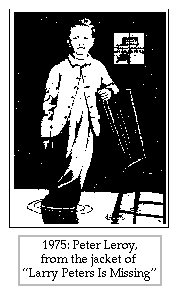
by Mark Dorset
from

![]() AKE
A TYPICAL CASE: for more than thirty years now, Eric Kraft has been working
to construct a single
large work of fiction composed of many smaller parts interconnected
in intricate ways . . . like a complex machine or a multi-celled organism
or a human society, or a bowl of clam chowder. His work began one cold
afternoon in the winter of 1962, when he dreamed up the central character
of this big work. Created would be far too grand a term, since Kraft
was dozing over a German lesson at the time. Here is the story as he tells
it:
AKE
A TYPICAL CASE: for more than thirty years now, Eric Kraft has been working
to construct a single
large work of fiction composed of many smaller parts interconnected
in intricate ways . . . like a complex machine or a multi-celled organism
or a human society, or a bowl of clam chowder. His work began one cold
afternoon in the winter of 1962, when he dreamed up the central character
of this big work. Created would be far too grand a term, since Kraft
was dozing over a German lesson at the time. Here is the story as he tells
it:
I was a sophomore in college. I had settled myself comfortably in a study carrel in the library. My feet were up; my chair was tilted back. The room was warm; I was tired. I dozed. When I woke up, I was lying on the floor, my books were scattered around me, people were laughing, and I was embarrassed. I gathered my things and rushed out of the library.
In the cold air, the memory of a dream returned to me, a dream that I had had while I was dozing there, before I tumbled to the floor. In the dream, or at least in the memory of it, I saw a nameless little boy sitting on a dilapidated dock, in the sunny warmth of a summer day, dabbling his feet in the water, playing a game: he was trying to bring the soles of his bare feet as close as he could to the surface of the water without touching it. The memory of that dream has never left me, and it continues to surprise me.

(Allow me to demur here, briefly. I do not object to Kraft’s designation of Peter Leroy as the narrator of “it all,” and I admit that as a creation of Leroy’s I am, therefore, a part of “it all,” but I submit to you, reader, the evidence of this demurrer to support the claim that I am the narrator of a good portion of “it all,” even if I am dummy to Leroy’s ventriloquist, as he is dummy to Kraft’s.)I think that all the details are true, but I also think that in fact they were widely separated in time and unrelated. Over the years, I’ve brought them closer together to make a story, improving their relationship without really altering the truth of any one of them, although I’ve certainly altered the truth of the totality of them. This impulse to improve on the past seems always to have been with me, and it is one of the traits I’ve given to the character who grew from the little boy on the dilapidated dock: Peter Leroy, the character at the center of all my work, and the narrator of it all.
Peter Leroy tells the sad story of his boyhood friend Matthew Barber in Reservations Recommended; the buoyant love story of his maternal grandparents in Herb 'n' Lorna; the trials and eventual triumph of the sultry older sister of his imaginary friend in What a Piece of Work I Am; and his own life story, greatly embellished, in LITTLE Follies,Where Do You Stop?, At Home with the Glynns, Leaving Small’s Hotel, and Inflating a Dog. He will, I hope, continue telling stories in many volumes to come.
 YEARS
PASSED after that dream in the library. From time to time, the memory of
the dream returned, and from time to time the dream itself returned. It
wasn’t an
obsession for Kraft—not yet. It may be now, but it wasn’t then. It
was just a pleasant amusement, a diversion, a vacation from whatever Kraft
was working on, thinking about, or worrying about. He could drift into
that dream and play with it, and in playing with it, exploring it, he began
improving it. He added a context for the boy—an island, where the old dock
was, an abandoned building on the island—a grand house, perhaps, or an
abandoned hotel—he wasn’t sure which, a gray bay, and the mainland, where
the town of Babbington lay. He wrote none of this down. This
was not writing—not yet. Kraft had
no intention or expectation of making a piece of writing out of this. It
was daydreaming.
YEARS
PASSED after that dream in the library. From time to time, the memory of
the dream returned, and from time to time the dream itself returned. It
wasn’t an
obsession for Kraft—not yet. It may be now, but it wasn’t then. It
was just a pleasant amusement, a diversion, a vacation from whatever Kraft
was working on, thinking about, or worrying about. He could drift into
that dream and play with it, and in playing with it, exploring it, he began
improving it. He added a context for the boy—an island, where the old dock
was, an abandoned building on the island—a grand house, perhaps, or an
abandoned hotel—he wasn’t sure which, a gray bay, and the mainland, where
the town of Babbington lay. He wrote none of this down. This
was not writing—not yet. Kraft had
no intention or expectation of making a piece of writing out of this. It
was daydreaming.
SOON, HOWEVER, like most people who read books, Kraft began to want to write one of his own. Like most people who want to write books, he really wanted to write a book about himself. He tried, but he found that he was too close to his subject. His feelings toward that subject, the “Eric Kraft” of the narrative he meant to write, were ambiguous. Kraft wanted “Kraft” to be something better than he was, and he respected that aspiration in “him,” but he wished that “he” could learn to live more comfortably with “himself,” and he could see that “he” would be better company if “he” could learn to laugh at “himself” now and then. Kraft began wanting to trip “him” up, play practical jokes on “him,” deflate “him.” In anything Kraft tried to write, he seemed—more and more often—to be about to make “Kraft” take a pratfall, and since Kraft was “Kraft” he didn’t want “him” falling down in any book he wrote.
Muse and the Subject
Sometimes, now, that beginning that once seemed so wrong seems like the only way I could have begun. I began writing about the dream. I was still trying to write about myself, of course, about my self and my dream, but as I worked I began to develop the dream more and more, and although I was merely exploring my own speculations about the dream and the little boy in it, I had begun a process that would eventually push me out of the story. It was as if a part of me were shouting, “Release me from the confines of memoir! Let me wander over yonder in the big, wide world of fiction!”
 IT
WAS ALSO AT ABOUT THIS TIME that Kraft invented an electromechanical game
that he called, at first, “The Game of Forking Paths” but later came to
call “The Babbington Game.” It was a switching game, in which nine
switches were arranged in a linked circuit so that the state of each switch
controlled the state of subsequent switches along the pathway. Nine
lights indicated the state of the various switches. The object of
the game was to set the switches so that all nine lights were lit.
This would have been a simple matter if the switches were toggle switches,
so that one could see the position of each switch, but Kraft used pushbutton
switches, so that the state of a switch could only be determined by observing
the effect that switching it had on the other switches. In other
words, one could only know the effect that a move would have on the state
of the entire array of lights after making the move. It seems to
me that there are implications about hyperfiction in the design of this
game, and if I had the time I would draw the schematic diagram of the game
and explore the hyperfictional implications further, but at the present
moment (on the morning of June 24, 2001) I do not. (I will say, however,
that it has just occurred to me that the game might also serve as a schematic
for the linked effect that the episodes of a serial novel have on their
readers, since the reading of any one episode will alter the reader’s understanding
of some, and perhaps all, of the other episodes—those to come and those
already read. And it has additionally just occurred to me that the
game models—in a greatly simplified way, of course—the relationships among
the characters in the author’s mind. Some day I really must get around
to including the schematic here.)
IT
WAS ALSO AT ABOUT THIS TIME that Kraft invented an electromechanical game
that he called, at first, “The Game of Forking Paths” but later came to
call “The Babbington Game.” It was a switching game, in which nine
switches were arranged in a linked circuit so that the state of each switch
controlled the state of subsequent switches along the pathway. Nine
lights indicated the state of the various switches. The object of
the game was to set the switches so that all nine lights were lit.
This would have been a simple matter if the switches were toggle switches,
so that one could see the position of each switch, but Kraft used pushbutton
switches, so that the state of a switch could only be determined by observing
the effect that switching it had on the other switches. In other
words, one could only know the effect that a move would have on the state
of the entire array of lights after making the move. It seems to
me that there are implications about hyperfiction in the design of this
game, and if I had the time I would draw the schematic diagram of the game
and explore the hyperfictional implications further, but at the present
moment (on the morning of June 24, 2001) I do not. (I will say, however,
that it has just occurred to me that the game might also serve as a schematic
for the linked effect that the episodes of a serial novel have on their
readers, since the reading of any one episode will alter the reader’s understanding
of some, and perhaps all, of the other episodes—those to come and those
already read. And it has additionally just occurred to me that the
game models—in a greatly simplified way, of course—the relationships among
the characters in the author’s mind. Some day I really must get around
to including the schematic here.)